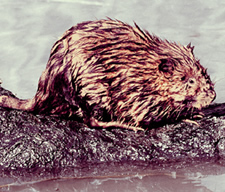Muskrats in South Carolina

Description
The muskrat (Ondatra zibethica) is not actually a rat, but is classified as a rodent because of its teeth: four large, yellowish incisors in the front of its mouth. The animal also has flat molars for grinding vegetation. Southeastern muskrats average about 2 pounds in weight and 2 feet in length, including a vertically flattened 8-to 12-inch tail. The waterproof fur is soft and thick and is generally dark brown on the back and sides, becoming light grayish-brown on the belly. The muskrat has a stocky appearance due to the apparent lack of a neck, and the ears are short and concealed in the fur. Its back feet are partially webbed and its smaller front feet are adapted for digging and feeding. The muskrat has lips that act as valves, closing behind the front incisors to allow it to gnaw underwater. The musky odor comes from two perineal scent glands located beneath the skin at the ventral base of the tail. This musk is used during the breeding season to mark an area.
Distribution
Muskrats are abundant in the Piedmont of South Carolina, and there are scattered populations in the Upper Coastal Plain as well. They are semi-aquatic mammals, living along streams and in lakes, ponds, swamps and marshes.
